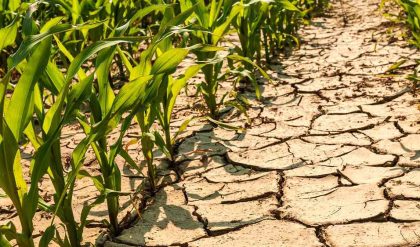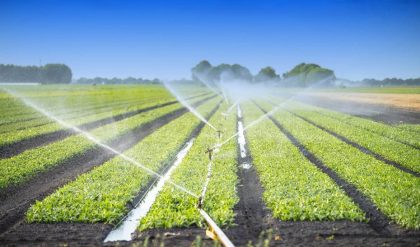All field crops need soil, water, air and light (sunshine) to grow. The soil gives stability to the plants; it also stores the water and nutrients which the plants can take up through their roots. The sunlight provides the energy which is necessary for plant growth (Fig. 1). The air allows the plants to “breath”.
Fig. 1 Plants need soil, water, air and sunlight ……

Without water crops cannot grow. Too much water is not good for many crops either. Apart from paddy rice, there are only very few crops which like to grow “with their feet in the water”. The most well-known source of water for plant growth is rain water. There are two important questions which come to mind: What to do if there is too much rain water? What to do if there is too little rain water?
If there is too much rain, the soil will be full of water and there will not be enough air. Excess water must be removed. The removal of excess water – either from the ground surface or from the root zone – is called drainage (see Volume 1, Chapter 6). If there is too little rain, water must be supplied from other sources; irrigation is needed (Fig. 2). The amount of irrigation water which is needed depends not only on the amount of water already available from rainfall, but also on the total amount of water needed by the various crops.

With respect to the need for irrigation water, a distinction can be made among three climatic situations:
1. Humid climates: more than 1200 mm of rain per year. The amount of rainfall is sufficient to cover the water needs of the various crops. Excess water may cause problems for plant growth and thus drainage is required.
2. Sub-humid and semi-arid climates: between 400 and 1200 mm of rain per year. The amount of rainfall is important but often not sufficient to cover the water needs of the crops. Crop production in the dry season is only possible with irrigation, while crop production in the rainy season may be possible but unreliable: yields will be less than optimal.
3. Semi-arid, arid and desert climates: less than 400 mm of rain per year. Reliable crop production based on rainfall is not possible; irrigation is thus essential.
The two major factors which determine the amount of irrigation water which is needed are:
the total water need of the various crops the amount of rain water which is available to the crops
In other words: the irrigation water need is the difference between the total water need of the crops and the amount of rainfall which is available to the crops. In Chapter 2 the crop water needs are discussed; Chapter 3 discusses the contribution from the rainfall while in Chapter 4 the determination of the irrigation water needs is explained (Fig. 3).
Fig. 3 Irrigation water need

In many countries it is already well known what the crop water needs and irrigation water needs are of the most commonly grown crops. Such data can usually be obtained from the Extension Service, the Irrigation Department or Ministry of Agriculture. It is then not necessary to determine the crop and irrigation water need. However, there may be situations where it is not possible to obtain these data and it would thus be necessary to determine them on the spot. Part I of this manual allows the reader to make a rough estimation of the crop and irrigation water needs – without using any complicated calculations. Part II of this manual allows the reader actually to calculate – be it in a fairly simple manner – the crop and irrigation water needs. These calculations obviously lead to a greater accuracy, but they also require more time and background knowledge.




